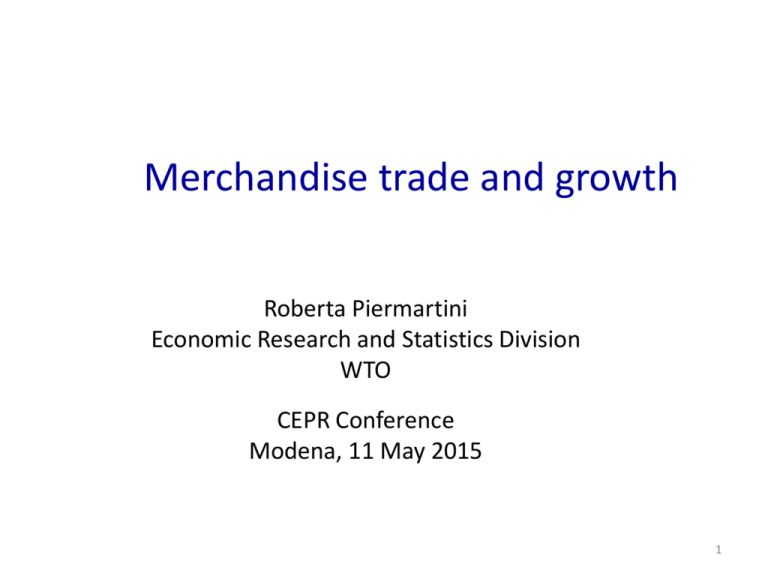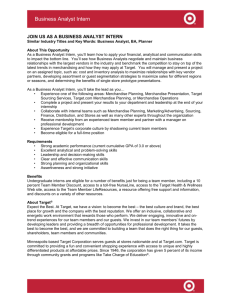Merchandise trade and growth - Centre for Economic Policy Research
advertisement

Merchandise trade and growth Roberta Piermartini Economic Research and Statistics Division WTO CEPR Conference Modena, 11 May 2015 1 “Fast growth is accompanied by increases in trade spurred by reduction in trade barriers and costs” WTR 2014 … BUT “Do we know by how much does trade fosters growth?” Outline Merchandise trade and growth … the debate today The evolution of merchandise trade and trade policy … point at an important role of supply chains What are the implication for trade and growth research? One new research: GVC and technology transfers 3 Merchandise trade correlates to growth Real per capita GDP growth and merchandise export volume growth, 2000-11 Note: annual growth rate Source: World Development Indicators and WTO Secretariat calculations. How does trade affect growth? Static gains from trade do not impact on long-run economic growth Trade can have a medium-term impact through its effects on factor accumulation (K) - a small open economy can sustain growth with capital accumulation only for an extensive period because return to capital are determined internationally Trade can affect growth in the long-run only if it contributes to technological progress - enhances the incentive to innovate (R&D) - fosters technological spillovers (A) - improves quality of institution (Q) Cross-country regression analysis: methodological problems Correlation versus causality? If we want to claim that integration affects income, we need to show that arrows (4) and (5) are the relevant ones, while arrows (6) – omitted variable – and (7) – reverse causality – are relatively insignificant 6 Terminator II: Rodrik et al. (2004) Rodrik et al.(2004) claim that “institutions rule” critique of Frankel and Romer (1999): “geography” –their instrument- affect institutions Once institutions (property rights, rule of law – instrumented with settlers’ mortality) are controlled for, trade has no effect on income per capita Openness contributes to income per capita only indirectly, via its positive effect on institutions 7 Further evidence Evidence based on within-country estimates Some countries grow much faster than others after opening up to trade… …others actually see their growth decline after opening up to trade (Waczairg and Welch (2008)) Why this heterogeneity? Bad regulation Freund and Bolaky (2008) … debate still going on Evidence on trade and technology transfers Keller (1998) Randomly created trade patterns give rise to positive international R&D spillover estimates, which are often larger, and explain more of the variation in productivity across countries than if true bilateral trade patterns are employed The finding casts doubt on the claim that patterns of international trade are important in driving R&D spillovers… 8 What do we know about merchandise trade? Merchandise trade account for an increasing share of GDP Merchandise trade account for an increasing share of GDP Source: World Bank World Development Indicators, WTO merchandise trade data and IMF WEO data What do we know about merchandise trade? Merchandise trade account for an increasing share of GDP New players have risen to prominence in world trade .. World centre of gravity has moved toward the East WTR, 2013 Figure B.5 Shares of selected economies in world merchandise exports by level of development, 1980-2011 (per cent) 1980 Mexico, 1% China, 1% 2011 Other developing and emerging, 15% Other developing economies, 16% European Union (15), 37% Singapore, 1% Chinese Taipei, 1% European Union (15), 30% Malaysia, 1% Brazil, 1% Indonesia, 1% South Africa, 1% Nigeria, 1% Iraq, 1% Fommer Soviet Union, 4% Developing and emerging economies, 34% Chinese Taipei, 2% Developed economies, 66% Thailand, 1% Brazil, 1% India, 2% Mexico, 2% Saudi Arabia, 2% Singapore, 2% Developing and emerging economies, 47% Developed economies, 53% Russian Federation, 3% Saudi Arabia, Kingdom of, 5% Other developed, 11% Source: WTO Secretariat. Japan, 6% United States, 11% Korea, Republic of, 3% United States, 8% China, 11% Japan, 5% Other developed, 11% WTR, 2013 Table B.15A Share of total trade between geographical regions in world trade, 1990 (per cent) North America Europe, 7.8% EuropeCIS, 3.6% CIS To Asia Europe North America South and Central AmericaAsia, 0.8% CISAsia, 0.7% South and Cental AmericaEurope, 1.6% North AmericaSouth and Central America, 2.6% South and Central America North America Middle East, 0.9% North AmericaAfrica, 0.7% EuropeAfrica, 3.4% EuropeMiddle East, 2.5% North Americ a-Asia, 10.2% Europe-Asia, 8.1% Middle East Middle EastAsia, 3.2% Asia To South and Central America Africa AfricaAsia, 0.6% Note: World trade includes intra-EU trade. Arrow weights based on shares in 1990. Trade within regions and with unspecified destinations represented 53% of world trade in 1990. Source: WTO Secretariat estimates. WTR, 2013 Table B.15B Share of total world trade between geographical regions in world trade, 2011 (per cent) North America Europe, 4.8% EuropeCIS, 3.6% CIS To Asia Europe North America South and Central AmericaAsia, 2.0% CISAsia, 1.3% South and Cental AmericaEurope, 1.4% North AmericaSouth and Central America, 2.1% South and Central America North America Middle East, 1.0% North AmericaAfrica, 0.8% EuropeAfrica, 2.3% EuropeMiddle East, 2.0% North Americ a-Asia, 7.8% Europe-Asia, 8.8% Middle East Middle EastAsia, 5.1% Asia To South and Central America Africa AfricaAsia, 1.7% Note: World trade includes intra-EU trade. Arrow weights based on shares in 1990. Trade within regions and with unspecified destinations represented 53% of world trade in 1990. Source: WTO Secretariat estimates. What do we know about merchandise trade? Merchandise trade account for an increasing share of GDP New players have risen to prominence in world trade .. World centre of gravity has moved toward the East Global supply chains have changed patterns of international trade .. - Service matter more than we thought. BUT …Contribution of services to trade is bigger than we thoughts Structure of world exports in gross terms, 2008 Structure of world exports in value added terms, 2008 12% 18% 23% 45% 37% 65% Primary products Manufacturing Services Primary products Source: WTO Secretariat estimates based on OECD-WTO 2008 data Manufacturing Services BACK TO TEXT 16 What do we know about merchandise trade? Merchandise trade account for an increasing share of GDP New players have risen to prominence in world trade .. World centre of gravity has moved toward the East Global supply chains have changed patterns of international trade .. - Service matter more than we thought. - Trade has tended to become more regionalized (S-S) WTR, 2013 Figure B.14 Intra-regional and extra-regional merchandise exports of WTO regions, 1990-2011 (US Billion and per cent) 5538 2707 2282 48% 71% 52% 1251 966 1225 706 44% 73% 65% 548 48% 59% 56% 41% 1990 2000 2011 85% 29% 35% 27% 1990 2000 268 2011 91% Europe (excl. EU-intra) North America 94% 1990 594 750 1658 138 52% 15% 2000 2011 51% 739 Middle East 58% 88% 74% 149 106 198 120 86% 74% 26% 26% 1990 2000 2011 South and Central America 94% 91% 1990 2000 1990 2000 Asia 12% 2011 Africa Intra 49% 42% Extra 2011 What do we know about merchandise trade? Merchandise trade account for an increasing share of GDP New players have risen to prominence in world trade .. World centre of gravity has moved toward the East Global supply chains have changed patterns of international trade .. - Service matter more than we thought. - Trade has tended to become more regionalized (S-S) - Trade grew faster than GDP since 1980 The elasticity of merchandise trade to GDP World merchandise trade volume and real GDP, 1980-2011 (annual per cent change) 8.0 2.5 7.0 2.0 6.0 5.0 1.5 4.0 1.0 3.0 2.0 0.5 1.0 0.0 0.0 1980-1985 1985-1990 GDP growth (left scale) 1990-1995 1995-2000 2000-2005 Merchandise trade volume growth (left scale) Source: WTO Secretariat. Note: Merchandise trade refers to the average of exports and imports. 2005-2011 Elasticity (right scale) What do we know about trade policy barriers in merchandise trade Trade costs have gone down over time MFN rates have fallen .. especially in intermediate inputs Preferential trade agreements (PTAs) continue to proliferate … - S-S PTAs are diffused - and are getting deeper and deeper This correlates with patterns of trade and supply chains, that are increasingly S-S MFN rates have fallen MFN rate (per cent) Bound rate (per cent) Bound lines (per cent) Average 200911 Change since 1996 Average 200911 Change since 1996 Average 200911 Change since 1996 World 8.5 -2.0 27.0 -3.8 80.1 12.9 Developed 2.7 -1.9 6.3 -1.3 98.9 -0.1 Emerging 10.1 -5.5 29.2 -9.8 80.0 7.9 Other developing 13.0 -1.7 29.6 -7.1 87.6 22.4 LDCs 7.1 -2.1 42.2 -2.4 45.5 8.4 Source: WTO Secretariat Note: Changes are from average 1996-98 to average 2009-11. The sample only includes those country-product pairs for which data are available on the status of bound lines, bound rates and imports for at least one year both at the beginning and at the end of the period. WTR, 2014 Figure C.26 Most-favoured nation (MFC) tariffs on parts and components by country group (per cent) Note: Underlying data are simple averages of ad valorem rates. Source: Calculations based on TRAINS database, WITS. What do we know about trade policy barriers in merchandise trade Trade costs have gone down over time MFN rates have fallen .. especially in intermediate inputs Preferential trade agreements (PTAs) continue to proliferate … - S-S PTAs are diffused - and are getting deeper and deeper This correlates with patterns of trade and supply chains, that are increasingly S-S Number of PTAs in force (1950-2010) 300 250 developing-developing developed-developing Number of PTAs 200 developed-developed 150 100 50 0 Year 25 WTR, 2014 Figure C.28 Average number of provisions by country group and period, 1992-2011 (number of PTAs) Source: WTO Secretariat. Note: Developed-Developing includes 42 the agreements between developed countries and all developing countries excluding LDCs. Emerging-Other Developing includes 25 agreements between emerging economies and other developing countries excluding LDCs. Each bar represents the average number of provisions included in the agreements signed in each time-period. WTR, 2014 Figure C.29 Share of emerging countries-other developing countries agreements including selected provisions, 1991-2011 (per cent) Source: WTO Secretariat. Note: The numbers represent the shares of agreement signed in a particular time-period between emerging countries and other developing countries that include a particular provision. There are 25 agreements involving both emerging and other developing countries. What are the implication for trade and growth research? The question of how trade affects growth needs to account for country’s heterogeneus particiaption in GVC account for internalikages between countries through GVC Use measures of trade that go Beyond merchandise trade... GVCs stress the importance of services trade and the interlinkages between trade in goods and in services Beyond tariff liberalization GVCs stress the importance of going beyond tariffs, to include non-tariff barriers and a range of other trade costs that are determinant of openess GVC affect R&D spillovers Source: Piermartini and Rubinova (2014) Note: "Vertically integrated countries" are defined as those country-pairs with a share of trade in intermediates above the median KNOWLEDGE SPILLOVERS THROUGH SUPPLY CHAINS Roberta Piermartini (WTO) and Stela Rubínova (IHEID) 21 April 2015 Brown Bag Seminar WTI - NCCR Trade Regulation (University Bern). Our contributions 1. We measure innovation with number of patents rather than TFP -we can link industry-level patents and industry level R&D due to the new concordance tables between IPC and ISIC 2. We can link spillovers to supply chains intensity using the new WIOD 3. Extend the analysis of knowledge spillovers to a sample of 29 countries (not just developed) 4. Work with a recent time period 2000-2008 5. Address endogeneity What do we do? We test whether accessibility of foreign knowledge depend on supply chains linkages between countries by estimating a steadystate function for the production of innovations where: Innovationsik =f(R&Djk, wijk) Where wijk is a measure of supply chain linkages when j is a foreign country. We find …. 1. Knowledge spillovers exist only for some forms of participation in supply chains relationships 2. Supply chains explain knowledge spillovers better than trade or distance when we extend the sample to 29 countries 3. Supply chains make knowledge spillovers less geographically localised Our empirical model I2P = Imports of inputs to produce I2E = Imports of inputs to export I2RE = Imports of inputs to re-export I2REP = Imports of inputs to re-export into production Estimated as a Negative binomial with industry and country fixed effects Variables: patent data We use number of patent applications (OECD Patent Statistics) - by inventor’s origin (applicants can reside in a different country) - filed under Patent Cooperation Treaty (to better control for different patent valuse than using national - by priority date (closer to the actual invention date) patent offices) Weights in R&D Pool In order of supply chain intensity links, the 4 weights in the knowledge Production function are constructed as: I2Pijk = Imported intermediatesjik I2Eijk = Imported intermediatesjik /Outputik∙ Exportsik I2REijk = Imported intermediatesjik /Outputik∙ Exportsijk I2REPijk = Imported intermediatesjik /Outputik∙ Intermediatesijk Assuming the share of imported intermediate inputs in output is the same as in exports we get the import content of exports. Dataset Averages over period 2000-2008 29 countries – three main supply chains clusters Factory Asia: China, Japan, South Korea, Chinese Taipei Factory NAFTA: Canada, Mexico, USA Factory CEE: Austria, Germany, Czech Republic, Hungary, Poland, Romania, Slovakia, Slovenia + other OECD countries and Russia and Turkey. 13 manufacturing industries aggregated in 8 groups (sorted by supply chain 25 Rubber and plastics products intensity) 26 Other non-metallic mineral products 23 29 24 27t28 30t33 Coke, refined petroleum products and nuclear fuel Machinery and equipment n.e.c. Chemicals and chemical products Basic metals, and fabricated metal products, except machinery and equipment Office, accounting and computing machinery; electrical machinery and apparatus n.e.c.; radio, television and communication equipment and apparatus; medical, precision and optical instruments, watches and clocks 34t35 Motor vehicles, trailers and semi-trailers; other transport equipment. Positive correlation between innovation and foreign R&D Result 1: Positive spillovers increase with the intensity of supply chain linkages (1) (2) (3) (4) (5) (6) (7) (8) Dependent: Patents R&D Pool I2P 0.0030* (0.0017) R&D Pool I2E 0.0007 (0.0010) 0.0028** (0.0013) R&D Pool I2RE 0.0007 (0.0009) 0.0071*** (0.0024) R&D Pool I2REP 0.0029* (0.0017) 0.259*** (0.0755) 0.696*** (0.118) 0.523* (0.276) 0.588*** (0.109) 3.558*** (1.231) 0.253*** (0.0758) 0.738*** (0.116) 0.491* (0.275) 0.606*** (0.112) 3.422*** (1.234) 0.246*** (0.0728) 0.735*** (0.113) 0.469* (0.280) 0.609*** (0.112) 3.451*** (1.227) 0.0087*** (0.0025) 0.252*** (0.0708) 0.729*** (0.113) 0.486* (0.281) 0.595*** (0.107) 3.572*** (1.197) Industry dummies (8) Country dummies (29) yes no yes no yes no Observations 201 201 201 ln(R&D) ln(GDP) ln(GDP per capita) ln(Researchers) ln(Patent protection) 0.141** (0.0551) 0.139** (0.0561) 0.132** (0.0546) 0.0042** (0.0018) 0.129** (0.0524) yes no yes yes yes yes yes yes yes yes 201 225 225 225 225 Result 2: distance is a less robust determinant of knowledge spillovers than supply chains Dependent: Patents (1) R&D Pool I2REP 0.0042** (0.0018) R&D Pool D Full Sample (2) (3) (4) 0.0084* (0.0045) -0.0056 (0.0035) 0.0044** (0.0018) -0.0061* (0.0036) (5) EU Sample (6) 0.0200* (0.0110) 0.0078 (0.0053 0.0081 (0.0152) ln(R&D) 0.124** (0.055) 0.154*** (0.055) 0.133** (0.057) 0.125 (0.098) 0.165* (0.089) 0.132 (0.099) Industry dummies (8) Country dummies (29/12) yes yes yes yes yes yes yes yes yes yes yes yes Observations 225 225 225 91 91 91 Country-clustered standard errors in parentheses *** p<0.01, ** p<0.05, * p<0.1 Result 3: trade is a less robust determinant of knowledge spillovers (1) (2) 6.35e-05 (0.0002) 0.0054*** (0.0020) -0.0002 (0.0002) (3) (4) (5) Dependent: Patents R&D Pool I2REP R&D Pool Imports R&D Pool Imports share 0.0041** (0.0020) 0.0073* (0.0043) 0.0007 (0.0039) R&D Pool Random ln(R&D) 0.145*** (0.0533) 0.126** (0.0507) 0.138*** (0.0515) 0.129** (0.0526) -0.0008 (0.00086) 0.145*** (0.0023) Industry dummies (8) Country dummies (29) yes yes yes yes yes yes yes yes yes yes Observations 225 225 225 225 225 Country-clustered standard errors in parentheses *** p<0.01, ** p<0.05, * p<0.1 Result 4: Supply chains can explain the decreasing importance of distance over time Results are robust to endogeneity ...1 First approach: look at the impact of R&D from G5 countries on innovation in other countries to mitigate the “reflection issue” R&D Pool I2REP from G5 R&D Pool I2REP from non-G5 G5 Sample non-G5 0.0010 (0.0035) 0.0029** (0.0013) 0.0073* (0.0041) 0.0115** (0.0052) Notes: The coefficient estimates are from regressions with the same specifi- cation as in Table 3, column (5). Results are robust to endogeneity .. 2 Second approach: use a panel specification with lagger R&D and R&D Pool variables to alleviate reverse causality Patentsikt = exp[α + β · ln(Stock R&D)ikt −1 + γ · Stock R&DPoolikt −1 +δ · ln( Patents)ikt −1 + ιτ + κτ ] + zikt . Panel regressions (1) (2) (3) (4) Dependent: Patents StockR&D Pool I2Pt −1 0.0084** (0.0037) 0.0047** (0.0019) StockR&D Pool I2Et −1 0.0078*** (0.0023) StockR&D Pool I2REt −1 0.0075*** (0.0020) StockR&D Pool I2REPt −1 0.0223** (0.0106) 0.788*** (0.048) 0.141*** (0.044) 0.0226** (0.0114) 0.794*** (0.049) 0.136*** (0.045) 0.0195* (0.0100) 0.785*** (0.048) 0.136*** (0.048) 0.0189* (0.0108) 0.778*** (0.047) 0.137*** (0.049) Country-year dummies Industry-year dummies yes yes yes yes yes yes yes yes Observations 664 664 664 664 ln(StockR&D)t −1 ln(Patents)t −1 Pre-sample fixed effects Country-clustered standard errors in parentheses *** p<0.01, ** p<0.05, * p<0.1 Instrument= IV regressions Industry’s dependence on external finance* Country’s financial development Cross-section averages NegBin Linear (1) (2) Dynamic panel NegBin Linear (3) (4) R&D Pool I2REP 0.0043* (0.0023) 0.0034* (0.0018) 0.0080** (0.0032) 0.0105** (0.0049) ln(R&D) 0.124*** (0.048) 0.091** (0.042) 0.008 (0.010) 0.008 (0.008) Dependent: Patents ln(Stock R&D)t −1 Country-year dummies Industry-year dummies yes yes yes yes yes yes yes yes First Stage F-statistic 327.66 378.47 1092.90 421.86 Observations 225 225 744 744 Bootstrapped standard errors in parentheses in (1) and (3). Country-clustered standard errors in parentheses in (2) and (4). *** p<0.01, ** p<0.05, * p<0.1 Conclusions • Findings: International production chains favour knowledge spillovers The effect is larger when the interdependence is stronger • Research: The emergence of new countries (China, Singapore, Korea) as new big contributors to the pool of innovation, may have something to do with factory Asia … not just these countries invested more in R&D, but factory Asia also increased the productivity of their R&D. Look for convergence clubs along the supply chain • Policy: There is an economic rationale for government intervention to foster participation in production networks. But, potential gains depend on the type of relationships



